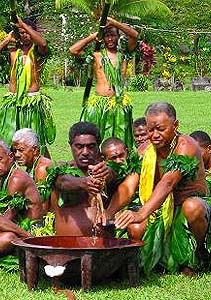 Even though the Christian missionaries tried to eradicate the use of this ancient and sacred plant, it was too “deeply rooted” in various cultures across the Pacific to be fully eliminated from the islands. As a result, Kava Kava is still used in various kava ceremonies and to mark special occasions.
Even though the Christian missionaries tried to eradicate the use of this ancient and sacred plant, it was too “deeply rooted” in various cultures across the Pacific to be fully eliminated from the islands. As a result, Kava Kava is still used in various kava ceremonies and to mark special occasions.
Kava originally had a revered place amongst high-ranking chiefs and elders, but its ceremonial use reaches as far and wide as a simple welcome for honored guests at a social event, to a mini celebration to mark the completion of a work-related project, to validate status, to celebrate a new birth or marriage, as well as honoring the recently deceased. Wherever a traditional toast with alcohol is made throughout the world, there is an equal, but with a fresh cup of Kava instead.
Also, in our corner of this luscious planet, the most intriguing ceremonial use of kava is when it’s consumed by an elder during divination ceremonies, as they attempt to make contact with the spirit world. In addition, we use kava to mark several key events in a child’s life, such as the naming of children who reach the ripe old age of one, to the consecrating of a male child, to initiating our precious girls into the traditions of hula and chant. In some places in the Pacific, it’s poured onto the ground instead of being consumed, just like the Greek tradition of throwing a glass of wine into the fire after a toast.
On one particular Polynesian island, where Kava Kava traditions remain a deeply integral part of the culture, political decisions are enacted during the kava ceremony, where enemies are also reconciled and goodwill is restored. Because this ceremony is so effective at returning a sense of balance and goodwill to the community, particular criminals have been pardoned and given their freedom thanks to the events that transpire! Now that’s some effective Kava!
Kava has a key role in high-ranking political and social ceremonies even today, and is the officially recognized way to welcome honored visitors. A long list of famous figures like Prince Charles have engaged in the Kava ceremony. Pope John Paul II even drank a cup upon his visit to the Pacific!
Lastly, just like the olive branch of the Bible shows a sign of peace and goodwill, so does the whole kava root when presented to a guest. IF you ever get handed a relatively ugly-looking tan root anytime during your visit to the Pacific, it’s not an insult; it’s a sign of honor and goodwill towards you by whomever gave it to you.
Aloha no,
Makaira





